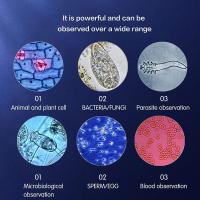Are Mites Microscopic ?
Yes, mites are microscopic arthropods that belong to the class Arachnida. They are typically less than 1 millimeter in size and can only be seen with the aid of a microscope. Mites are found in a wide range of habitats, including soil, water, and on plants and animals. Some species of mites are parasitic and can cause skin irritation or disease in humans and animals. Other species of mites are beneficial, such as those that help to decompose organic matter in soil or those that prey on other pests. Overall, mites are an important part of many ecosystems and play a variety of roles in the natural world.
1、 Morphology and Anatomy of Mites
Yes, mites are microscopic arthropods that belong to the class Arachnida. They are typically less than 1 millimeter in length and are not visible to the naked eye. Mites are found in a wide range of habitats, including soil, water, and on plants and animals.
The morphology and anatomy of mites vary depending on the species. However, most mites have a body that is divided into two main parts: the cephalothorax and the abdomen. The cephalothorax contains the head and thorax, while the abdomen contains the digestive, reproductive, and respiratory systems.
Mites have four pairs of legs, which are attached to the cephalothorax. The legs are covered in hairs and spines, which help the mites to move and cling to surfaces. Mites also have sensory organs, including eyes, antennae, and sensory hairs, which help them to detect their environment.
Recent research has revealed new insights into the morphology and anatomy of mites. For example, studies have shown that some mites have specialized mouthparts that allow them to feed on specific types of food, such as blood or plant sap. Other studies have focused on the respiratory system of mites, which is highly adapted to their small size and allows them to extract oxygen from their environment efficiently.
Overall, the morphology and anatomy of mites are complex and diverse, reflecting the wide range of habitats and lifestyles that these tiny arthropods occupy.
2、 Life Cycle and Reproduction of Mites
Yes, mites are microscopic arthropods that belong to the class Arachnida. They are typically less than 1 millimeter in size and can only be seen with the aid of a microscope. Mites are found in a wide range of habitats, including soil, water, and on plants and animals.
The life cycle of mites varies depending on the species, but most mites go through four stages: egg, larva, nymph, and adult. Mites reproduce sexually, with males transferring sperm to females during mating. Some species of mites are known to reproduce asexually as well.
Mites are important in many ecosystems as decomposers, predators, and parasites. Some species of mites are beneficial to humans, such as those used in the production of cheese and other fermented foods. However, other species of mites can cause problems for humans, such as dust mites that can trigger allergies and asthma.
Recent research has shed light on the complex interactions between mites and their hosts. For example, studies have shown that some species of mites can manipulate the behavior of their hosts to increase their chances of survival and reproduction. Other research has focused on the use of mites as bioindicators of environmental health, as their presence or absence can indicate the quality of soil or water in an ecosystem.
3、 Ecological Roles of Mites
Yes, mites are microscopic arthropods that belong to the class Arachnida. They are typically less than 1 millimeter in size and can be found in a wide range of habitats, including soil, water, and on plants and animals. Despite their small size, mites play important ecological roles in many ecosystems.
One of the most important roles of mites is as decomposers. Many species of mites feed on dead plant and animal material, breaking it down into smaller particles that can be used by other organisms. This process is essential for nutrient cycling and helps to maintain healthy ecosystems.
Mites also play important roles as predators and parasites. Some species of mites feed on other arthropods, including insects and other mites, helping to control their populations. Other mites are parasites of plants and animals, causing damage and disease.
Recent research has also highlighted the important role that mites play in soil health. Mites are known to interact with soil bacteria and fungi, helping to regulate nutrient cycling and soil structure. They also play a role in the decomposition of organic matter, which can help to improve soil fertility.
Overall, mites are an important and diverse group of organisms that play a vital role in many ecosystems. While they are often overlooked due to their small size, their ecological contributions are significant and warrant further study and conservation efforts.
4、 Medical and Veterinary Importance of Mites
Yes, mites are microscopic arthropods that belong to the class Arachnida. They are typically less than 1 millimeter in size and are found in a wide range of habitats, including soil, water, and on plants and animals. Mites are important in both medical and veterinary fields due to their ability to cause a variety of diseases and allergies.
In humans, mites such as the dust mite and scabies mite can cause allergic reactions and skin irritation. Dust mites are a common cause of asthma and allergic rhinitis, while scabies mites can cause intense itching and skin rashes. In veterinary medicine, mites can cause mange in dogs and cats, as well as ear infections and skin irritation.
Recent research has also highlighted the potential role of mites in the transmission of diseases such as Lyme disease and Zika virus. While the exact mechanisms of transmission are still being studied, it is believed that mites may act as vectors for these diseases, transmitting them from one host to another.
Overall, the medical and veterinary importance of mites cannot be overstated. As our understanding of these tiny arthropods continues to grow, it is likely that we will discover even more ways in which they impact our health and wellbeing.


































